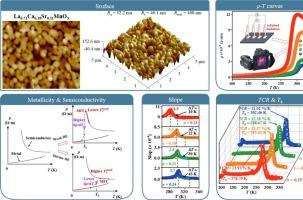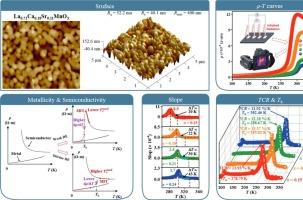The comprehensive study of the relationship between electrical transport mechanisms and peak TCR for La0.89−xCaxSr0.11MnO3 films
IF 6.9
2区 材料科学
Q2 CHEMISTRY, PHYSICAL
引用次数: 0
Abstract
At present, perovskite manganite films are at the frontier of the uncooled bolometer materials technology. It is of great significance to explore the perovskite manganite with high temperature coefficient of resistivity (TCR) at room temperature and the influencing factors of peak TCR value. Herein, perovskite manganite films with the formula of La0.89−xCaxSr0.11MnO3 (LCSMO) were prepared by a facile spin-coating method with improved sintering temperature. The testing results indicated that Mn-O bond length, Mn4+ content, and grain size of films decreased as x decreased. The combination of strengthening semiconductivity and reducing the metal–insulator transition temperature enabled the film to achieve a high TCR with a maximum value of 13.37 %/K and resulted in a Tk of 293.02 K when x = 0.18. Specifically, the improved peak TCR value of the La0.71Ca0.18Sr0.11MnO3 film can be explained by its high hopping activation energy, lower theoretical Curie Temperature and mobility, as well as electron scattering mediated by La3+ doping. Basically, inhibiting the metal–insulator transition temperature, lower metallicity resistivity, and higher semiconductor resistivity play a crucial role in controlling the peak TCR value. This finding provides a theoretical basis for explaining ρ–T curve variation trend from the fundamental perspective of semiconductor transport properties.


La0.89−xCaxSr0.11MnO3薄膜电输运机制与峰值TCR关系的综合研究
目前,钙钛矿-锰矿薄膜处于非冷却测热计材料技术的前沿。研究常温下具有高温电阻率系数(TCR)的钙钛矿型锰矿及其TCR峰值的影响因素具有重要意义。在提高烧结温度的条件下,采用快速旋涂法制备了分子式为La0.89−xCaxSr0.11MnO3 (LCSMO)的钙钛矿型锰酸盐薄膜。测试结果表明,随着 x 的减小,膜的Mn-O键长、Mn4+含量和晶粒尺寸减小。增强半导体性和降低金属-绝缘体转变温度的结合使薄膜获得了较高的TCR,最大值为13.37 %/K,当 x = 0.18时,Tk为293.02 K。具体来说,La0.71Ca0.18Sr0.11MnO3薄膜TCR峰值的提高可以通过其高跳变活化能、较低的理论居里温度和迁移率以及La3+掺杂介导的电子散射来解释。基本上,抑制金属-绝缘子转变温度、降低金属性电阻率和提高半导体电阻率是控制TCR峰值的关键。这一发现为从半导体输运性质的基本角度解释ρ-T曲线变化趋势提供了理论依据。
本文章由计算机程序翻译,如有差异,请以英文原文为准。
求助全文
约1分钟内获得全文
求助全文
来源期刊

Applied Surface Science
工程技术-材料科学:膜
CiteScore
12.50
自引率
7.50%
发文量
3393
审稿时长
67 days
期刊介绍:
Applied Surface Science covers topics contributing to a better understanding of surfaces, interfaces, nanostructures and their applications. The journal is concerned with scientific research on the atomic and molecular level of material properties determined with specific surface analytical techniques and/or computational methods, as well as the processing of such structures.
 求助内容:
求助内容: 应助结果提醒方式:
应助结果提醒方式:


